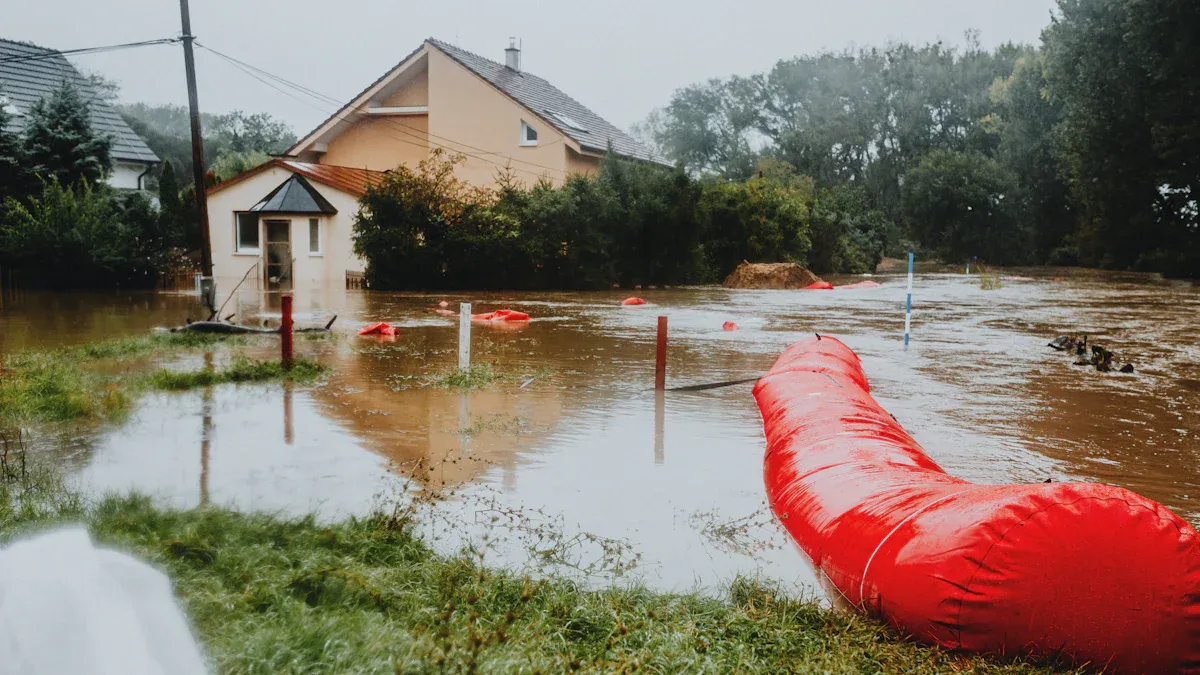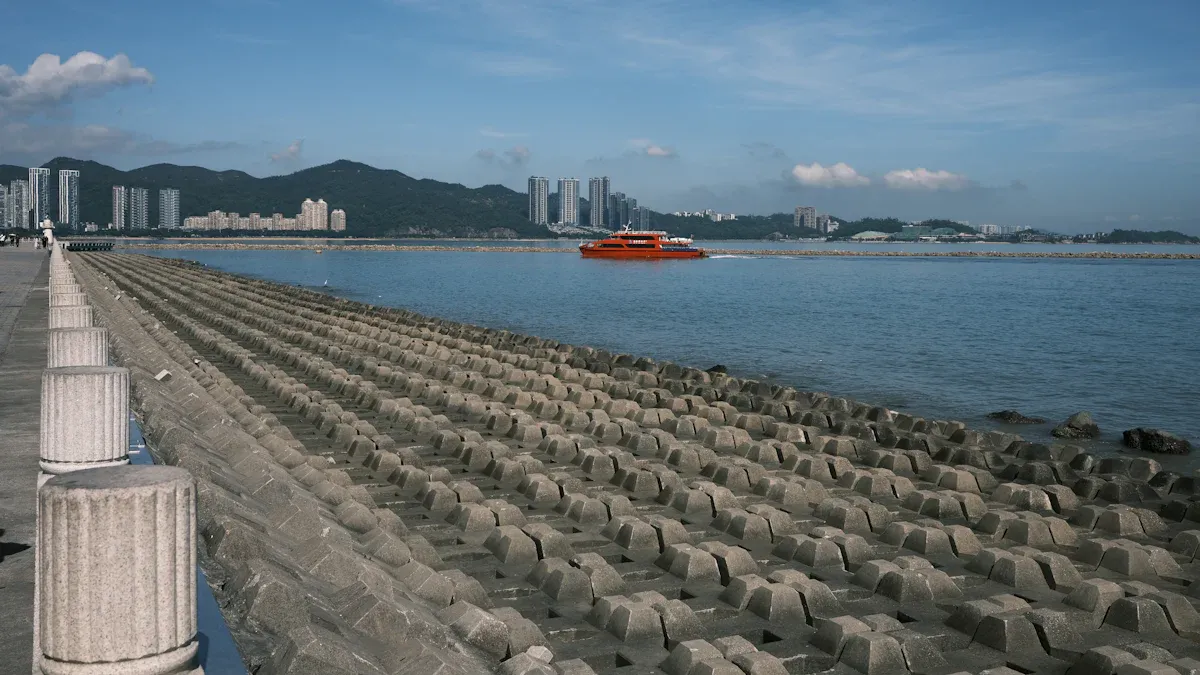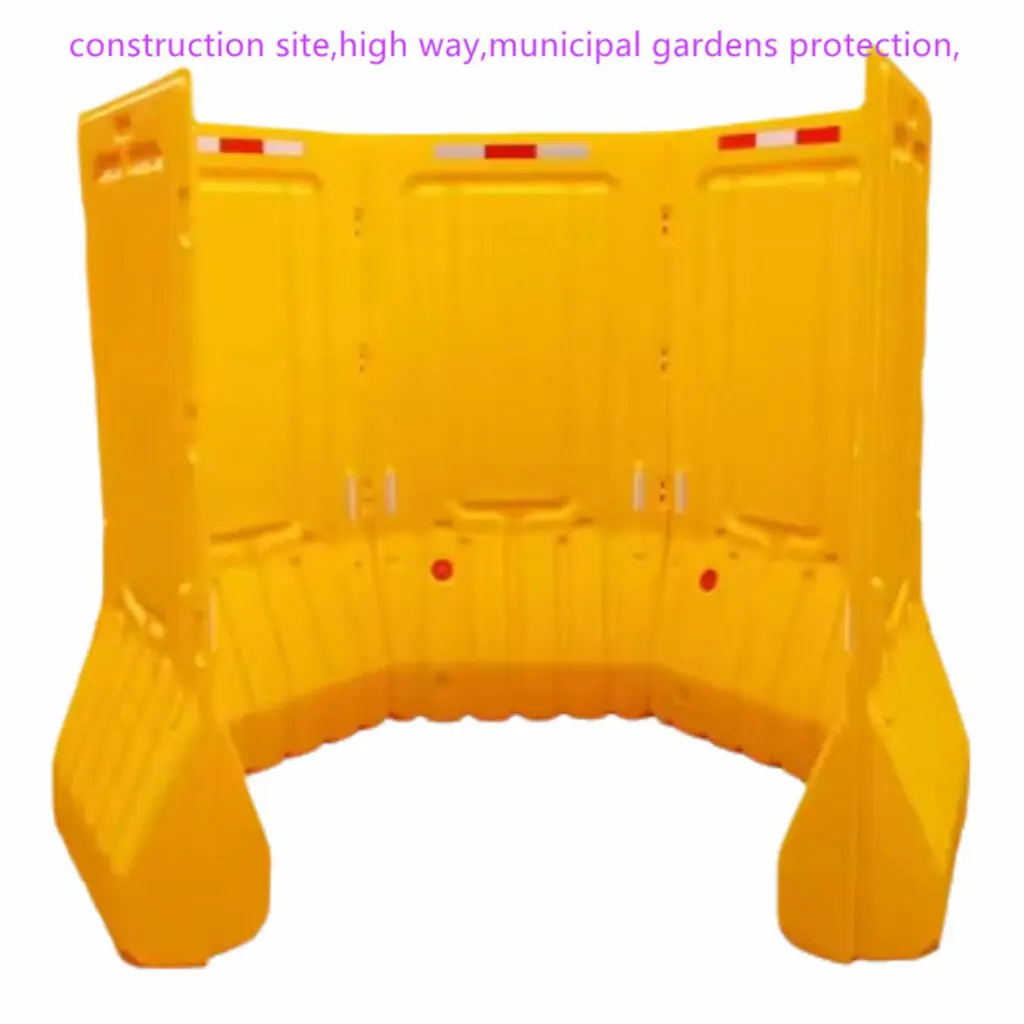
You want the best shot at preventing flood damage in 2025? Start by knowing your property’s unique risks. Flooding caused about $1.1 billion in damages last year, and experts say river flooding could cost up to $5.9 billion in 2025. Get a flood risk surveyor or a hydrologist to check your home’s weak spots. Look for advanced water barrier options like smart membranes or new acrylic tech. Taking action early can lower repair costs, help with insurance, and protect your home’s value.
Key Takeaways
- Check your flood risk by looking at local dangers and old flood records. This helps you know what makes your property weak to floods.
- Pick the best flood barrier for what you need. Temporary barriers work well for fast protection. Permanent barriers keep you safe for a long time.
- Choose strong materials for your flood barriers. Good metals and tough plastics last longer. They do not get damaged by water or sun easily.
- Use a checklist when you put in flood protection products. This helps you set them up right. It also helps stop water from getting into your house.
- Ask experts if you do not know which flood control to use. Their advice can help you save time and money when getting ready for floods.
Assessing Flood Risk

Local Hazards
Start by checking what dangers are near you. Flooding is the most costly natural disaster in the U.S. It has caused about $1.7 trillion in damage since 1980. Storms are getting worse and happening more often. This means homes and businesses are at higher risk. If you live in a flood zone, you need flood insurance before you get a loan. The National Flood Insurance Program can help you with this.
Think about how your area and the weather affect your flood plan:
| Evidence Description | Impact on Flood Risk |
|---|---|
| Urbanization changes water flow and increases runoff. | Higher flood peaks and longer water accumulation. |
| Extreme rainfall events are more common. | Drainage systems can’t keep up, leading to urban flooding. |
| Wetlands replaced by roads and buildings. | More areas become vulnerable to flooding. |
Tip: Look at old flood records for your area. Check past floods, rainfall, and river levels. This helps you know what kind of flooding could happen. It also shows how long water might stay on your land.
Property Vulnerabilities
Next, look at weak spots on your property. Cities have more hard surfaces like roads and buildings. Rainwater cannot soak into the ground. It runs off and gathers in low places. Bad drainage makes flooding worse. Check your home for weak spots like basement windows, doors, and garage entries. These places need strong flood protection.
Make a checklist for your flood plan:
- Find all places where water can get in, like driveways and walkways.
- Think about using a water barrier or road barrier to stop floodwater.
- Put up road barricades if you need to move water away from your home.
- Check your drainage system and improve it if needed.
- Try to protect the environment by planting native plants or fixing wetlands.
Flood risk assessment looks at hazards, exposure, and weak spots. You can use national databases and models to get more details. This helps you pick the best flood protection and water barrier for your home. Remember, protecting the environment helps lower future risks.
Types of Flood Barriers

Flooding can hit fast, so you need the right flood barriers for your home or business. You have two main choices: temporary flood barriers and permanent flood barriers. Each type works best in different situations.
Temporary Flood Barriers
Temporary flood barriers give you quick protection when storms roll in. You can set them up before heavy rain and take them down when the danger passes. Here are some common types:
- Water-filled tubes: You fill these with water to create a strong wall. They work well for driveways and walkways.
- Sandbags: These are the classic choice. You stack them to block water, but they can be heavy and not fully water-resistant.
- Metal or plastic panels: You snap these into place across doors or windows. They are easy to store and reuse.
Temporary flood barriers cost less than permanent ones. For example, water-inflated barriers range from $20 to $300, depending on size. Metal or plastic panels cost about $50 to $150 per square foot.
Tip: Temporary flood protection barriers are great if you want flexibility. You can move them where you need them most, and they leave no mark on your property.
Permanent Flood Barriers
Permanent flood barriers stay in place all year. They protect your property from flooding without extra setup. You might see floodwalls made of concrete or berms built from packed clay. These barriers handle strong storms and high water.
- Floodwalls and berms: These block water from entering your property. They work well for homes and businesses in flood zones.
- Door dams and window shields: These fit over entry points and keep water out.
Permanent flood barriers cost more to install, but they last for years. They need little maintenance and stand up to tough weather. You should check them often to make sure they stay strong. If you have a road barrier or road barricade, you can use it with other flood protection barriers for extra safety.
Note: Permanent flood barriers give you peace of mind. They work best if you face regular flooding or want long-term protection.
| Barrier Type | Cost Range |
|---|---|
| Metal or Plastic Panel | $50 – $150 per sq ft |
| Water-Inflated Barriers | $20 – $50 (small), $100 – $300 (large) |
Flood barriers come in many forms. Choose the water barrier that fits your needs and budget. Always think about how often flooding happens in your area and how much protection you want.
Choosing Water Barrier Materials
Durability Factors
When you choose materials for flood barriers, you want them to last a long time. High-grade metals and reinforced plastics are good for long-term use. You might see MgO boards, OSB panels, and plywood in water barrier systems. Each one has its own good and bad points. Look at this table to compare them:
| Material | Moisture Resistance | Durability | Lifespan |
|---|---|---|---|
| MgO Boards | Excellent, no swelling or mold | Long-lasting, strong | Up to 100 years |
| OSB Panels | Moderate, can swell and mold | Loses strength after wet/dry cycles | Varies, can be ruined if wet too long |
| Plywood | Better than OSB, but can still mold | Loses about 9% strength after wet/dry cycles | Varies, can be ruined if wet too long |
MgO boards are best for keeping out water and can last up to 100 years. OSB and plywood are okay for short-term use but may not last through many floods. For road barrier or road barricade systems, you need materials that can handle water and lots of use.
Reinforced plastics like FRP are very strong. They can last 75-100 years or more. They do not rust or break down from sunlight. Steel can last a long time too, but you have to take care of it so it does not rust. Plastics need less care and can save you money over time.
Tip: Pick materials that fit your local flood risk. If you get lots of storms, buy strong flood barriers that last.
Corrosion and UV Resistance
Flood barriers have to deal with tough weather. You need materials that do not rust or get damaged by the sun. Nonferrous metals work well in wet places. Protective coatings help keep steel and other metals safe from rust. For plastics, make sure the resin can handle sunlight. Look for products that meet ASTM D4329 standards for UV resistance.
| Best Practice | Description |
|---|---|
| Material Selection | Use nonferrous metals for better corrosion resistance in marine environments. |
| Protective Coatings | Apply barrier protection coatings to isolate structures from corrosive environments. |
| Design Considerations | Avoid designs that trap water to reduce deterioration risks. |
| UV Resistance | Ensure resins are formulated for UV resistance and follow ASTM D4329 standards. |
Think about the environment too. Some materials can hurt soil and water if not handled right. Try to pick flood barriers and water barrier products that are safe and easy to recycle.
Evaluating Flood Protection Products
Effectiveness
You want flood protection products that work every time. It is important to see how well each product keeps water out. You also need to check if it fits your property. Some products are better for homes. Others work best for businesses or public places. NOAQ Boxwall, Geodesign Flood Barriers, and Inero Flood Barriers are easy to set up fast. You do not need to fill them with anything, so you save time in emergencies. Metal or composite barriers take longer to put in place. They need rails or brackets to hold them up.
| Product Type | Installation Speed | Installation Requirements |
|---|---|---|
| NOAQ Boxwall | Quick | No fill material needed for deployment |
| Geodesign Flood Barriers | Quick | No fill material needed for deployment |
| Inero Flood Barriers | Quick | No fill material needed for deployment |
| General Metal/Composite Barriers | Moderate | Requires mounting rails, brackets, or other hardware |
You should check if the products meet safety rules. In 2025, the best products must follow rules like ASCE 24-24. This rule covers areas that can flood once in 500 years. Dry floodproofing solutions must pass ANSI/FM 2510 tests. Pick products that get checked every year. Good products have warning systems that tell you about floods 12 to 36 hours before they start.
Tip: Always choose flood protection products that meet the newest safety rules. This helps keep your flood control system strong and safe.
Installation and Cost
You do not want a hard setup when flooding happens. Most flood protection products are simple to install. You do not need special tools. Just clear the area, put the water barrier or road barrier down, and check for gaps. Water-activated products start working when they touch water. Check the fit often, especially if you use a road barricade for more flood control.
Here’s a simple checklist for installing flood protection products:
- Find the spots that need flood control.
- Clear away trash for a good fit.
- Put the flood protection products where you need them.
- Activate water-activated barriers.
- Look for gaps and fix them.
- Check barriers during flooding.
Flood protection products for homes usually cost less than for businesses. Products made in the USA are needed for big projects, like airports or government buildings. This helps local workers and makes sure you get good materials.
| Standard/Requirement | Description |
|---|---|
| ASCE 24-24 | Regulates flood hazard area up to 500-year floodplain |
| Elevation Requirements | Sets minimum flood elevation by building type |
| Performance Testing | Requires ANSI/FM 2510 for dry floodproofing solutions |
| Annual Inspection | Needs regular maintenance and drills |
| Flood Warning System | Alerts for deployment 12-36 hours in advance |
Flood protection products help you feel safe. You can protect your property from floods and keep your flood control system ready for any storm.
Water Barrier Selection Guide
Step-by-Step Checklist
Picking the right flood barriers can seem hard at first. You can make it easier by following these steps. Use this checklist to help you choose the most effective water barrier for your property:
- Check Performance Standards
Make sure your flood barriers can handle the water and pressure you might get. Look for products that show their tested limits. - Look for Durability
Choose materials that do not rust or break from the sun. Reinforced plastics and strong metals last longer, especially if you get floods often. - Review Legal and Regulatory Rules
Some places need permits for flood control systems. Ask your local Department of Environmental Protection about the rules. - Think About Community Safety
Your flood barriers should protect your home and help your neighbors too. Good barriers can stop water from spreading to other homes. - Consider Environmental Impact
Pick a water barrier that keeps water clean and does not hurt plants or animals. Some designs help wetlands and lower runoff. - Check Installation and Removal
You want a flood barrier that is easy to set up fast. Look for simple designs, especially if you need to move a road barrier or road barricade in an emergency. - Test Structural Integrity
Make sure your barriers stay strong in all flood conditions. Check for good anchors and stable designs. - Verify Certification
Only use flood barriers tested and certified by trusted groups. This helps you know your flood control system will work when you need it.
Tip: Keep this checklist with you when you shop for flood barriers. It helps you remember what is important and not miss any steps.
Common Mistakes
Many people make the same mistakes when picking a water barrier or setting up flood control. You can avoid these problems if you know what to look for:
- Skipping Critical Details
Some people forget to connect different materials the right way. If you do not seal the edges between a wall and a window, water can get in. Always check the spots where things meet and make sure every part fits well. - Choosing the Wrong Moisture Management
Not all flood barriers work for every climate. If you pick the wrong type, your flood control might not work. Think about your local weather and how much flooding you get each year. - Ignoring Flashing and Caulking
If you do not put in flashing or caulking the right way, water can hurt your walls. Measure carefully and follow the steps. This keeps your home safe and stops stains or mold.
Note: If you are not sure, ask for help. Local flood insurance agents can give advice on coverage and risk. Companies like JMI Windows & Doors can help you find the right water barrier for your doors and windows. The Flood Defense Group gives expert tips and has many flood barriers. These experts can help you make a strong flood protection plan.
You do not have to figure out flood control by yourself. Ask professionals if you have questions about road barriers, road barricades, or any other flood protection products. Getting advice now can save you time and money when flooding happens.
You can protect your home from flooding by following a few smart steps. Start with a flood control plan that matches your property’s needs. Custom solutions, like the Church By The Sea’s flood panels, show how tailored barriers can keep out water and handle tough storms. Many programs in 2025, such as the National Coastal Resilience Fund, help you pay for flood control and water barrier upgrades. Don’t wait for flooding to strike. Talk to experts, check your road barrier and road barricade options, and take action now to keep your property safe.
FAQ
What is the difference between a water barrier and a road barrier?
A water barrier stops water from entering your property during floods. A road barrier blocks cars or people from certain areas. You might use both for flood control, but each has a different job.
How do I know if I need a permanent or temporary flood barrier?
If you face floods often, you should pick a permanent water barrier. For rare storms, a temporary barrier works well. Think about your flood control needs and how fast you need to set up protection.
Can I install flood control products myself?
You can install many flood control products on your own. Some, like a road barricade or water barrier, are easy to set up. For large or complex systems, you may want help from a professional.
How long do flood barriers last?
Most water barriers last many years if you take care of them. Some materials, like reinforced plastic, can last decades. Always check your flood control products after each storm.
Do I need to maintain my flood control system?
Yes, you need to check your flood control system often. Look for damage or leaks. Clean your road barrier and water barrier after each use. Good care keeps your flood protection strong.






